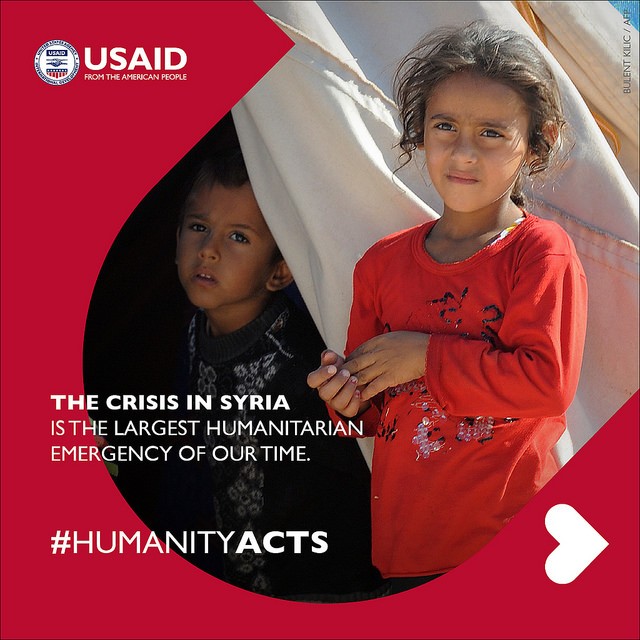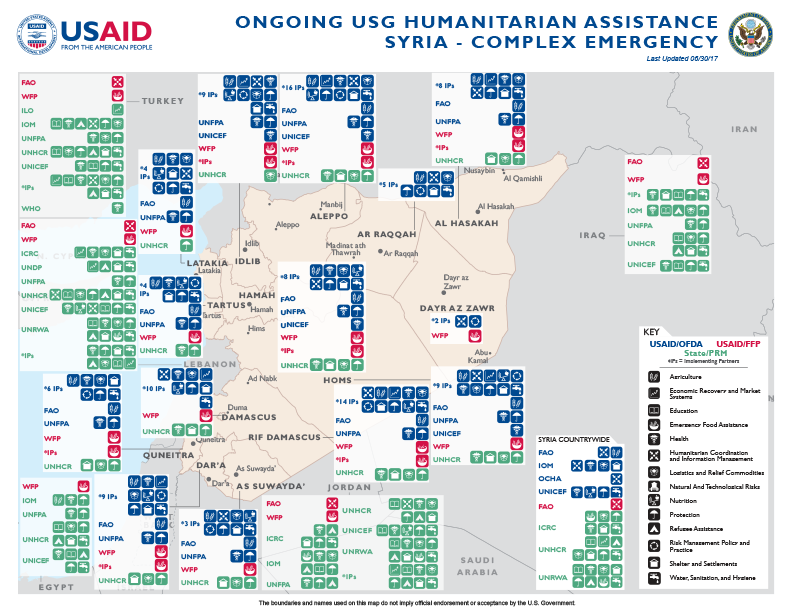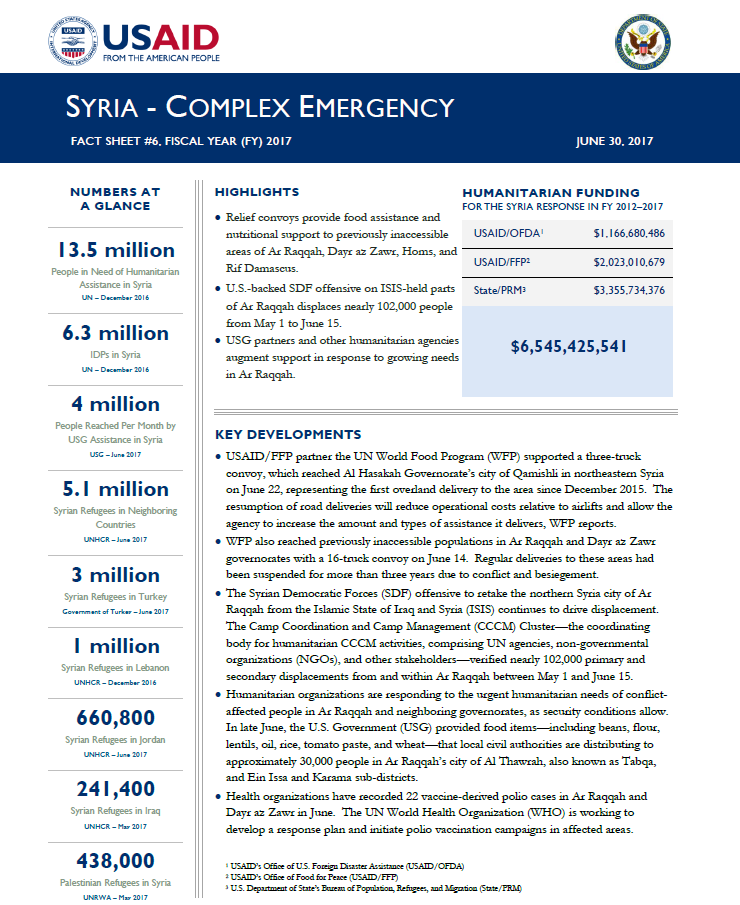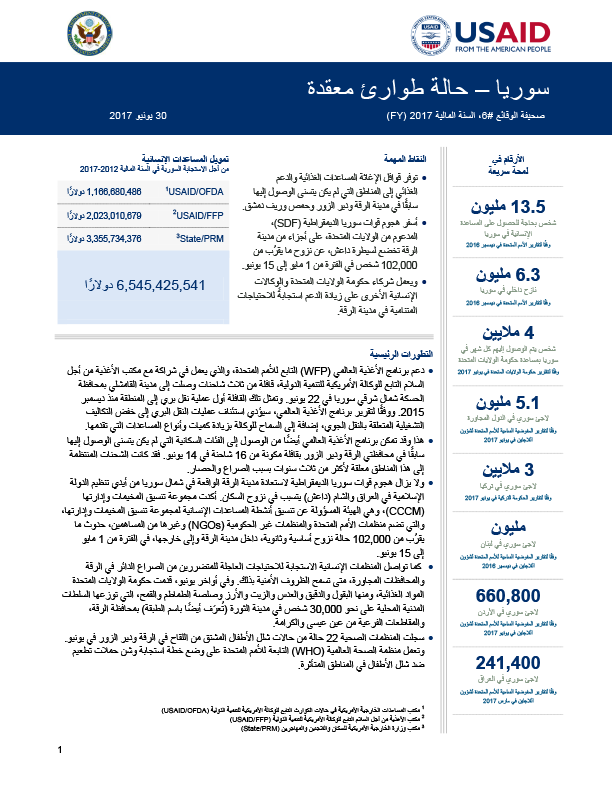- What We Do
- Agriculture and Food Security
- Democracy, Human Rights and Governance
- Economic Growth and Trade
- Education
- Ending Extreme Poverty
- Environment and Global Climate Change
- Gender Equality and Women's Empowerment
- Global Health
- Water and Sanitation
- Working in Crises and Conflict
- Disaster Assistance
- Political Transition Initiatives
- Conflict Mitigation and Prevention
- Countering Violent Extremism
- Disaster Risk Reduction
- Peacebuilding and Reconciliation
- Providing Safe & Secure Environments for Development
- Recovering From Crisis
- Resilience
- Tech Challenge for Atrocity Prevention
- World Humanitarian Day
- U.S. Global Development Lab
June 30, 2017
Highlights
Relief convoys provide food assistance and nutritional support to previously inaccessible areas of Ar Raqqah, Dayr az Zawr, Homs, and Rif Damascus.
U.S.-backed Syrian Democratic Forces offensive on ISIS-held parts of Ar Raqqah displaces nearly 102,000 people from May 1 to June 15.
US Government partners and other humanitarian agencies augment support in response to growing needs in Ar Raqqah.
Key Developments
USAID/FFP partner the UN World Food Program (WFP) supported a three-truck convoy, which reached Al Hasakah Governorate’s city of Qamishli in northeastern Syria on June 22, representing the first overland delivery to the area since December 2015. The resumption of road deliveries will reduce operational costs relative to airlifts and allow the agency to increase the amount and types of assistance it delivers, WFP reports.
WFP also reached previously inaccessible populations in Ar Raqqah and Dayr az Zawr governorates with a 16-truck convoy on June 14. Regular deliveries to these areas had been suspended for more than three years due to conflict and besiegement.
Syria Complex Emergency - Map #6 - 06/30/2017 ![]() (pdf - 483k)
(pdf - 483k)
Numbers At A Glance
13.5 million
6.3 million
4 million
5.1 million
3 million
1 million
660,800
241,400
438,000
Humanitarian Funding
To Syria Humanitarian Response
FY 2012 - FY 2017
| USAID/OFDA | $1,166,680,486 |
| USAID/FFP | $2,023,010,679 |
| State/PRM | $3,355,734,376 |
| TOTAL | $6,545,425,541 |
Syria Complex Emergency - Fact Sheet #6 (FY2017) ![]() (pdf - 249k)
(pdf - 249k)
The Syrian Democratic Forces (SDF) offensive to retake the northern Syria city of Ar Raqqah from the Islamic State of Iraq and Syria (ISIS) continues to drive displacement. The Camp Coordination and Camp Management (CCCM) Cluster—the coordinating body for humanitarian CCCM activities, comprising UN agencies, non-governmental organizations (NGOs), and other stakeholders—verified nearly 102,000 primary and secondary displacements from and within Ar Raqqah between May 1 and June 15.
Humanitarian organizations are responding to the urgent humanitarian needs of conflictaffected people in Ar Raqqah and neighboring governorates, as security conditions allow. In late June, the U.S. Government (USG) provided food items—including beans, flour, lentils, oil, rice, tomato paste, and wheat—that local civil authorities are distributing to approximately 30,000 people in Ar Raqqah’s city of Al Thawrah, also known as Tabqa, and Ein Issa and Karama sub-districts.
Health organizations have recorded 22 vaccine-derived polio cases in Ar Raqqah and Dayr az Zawr in June. The UN World Health Organization (WHO) is working to develop a response plan and initiate polio vaccination campaigns in affected areas.
INSECURITY AND POPULATION DISPLACEMENT
The CCCM Cluster recorded the displacement of more than 913,600 people from conflict-affected areas throughout Syria between June 2016 and June 2017, including an estimated 14,500 new displacements in the first two weeks of June 2017 alone. The overall figure includes nearly 875,600 displacements from affected areas in northern Syria, including Aleppo, Al Hasakah, Ar Raqqah, Dayr az Zawr, Hamah, Homs, Idlib, and Latakia governorates, and more than 38,000 displacements from southern Syria’s As Suwayda’, Damascus, Dar’a, and Rif Damascus governorates.
Northern Syria
The U.S.-backed SDF offensive in Ar Raqqah continues to prompt population displacement within and from the governorate. As of June 15, the CCCM Cluster had verified more than 215,300 primary and secondary displacements from Ar Raqqah since November; nearly 102,000 of the displacements occurred between May 1 and June 15. New displacement and returns continue in Ar Raqqah, and civilians face a number of protection concerns, including the risk of explosive remnants of war, threats of ISIS retaliation, forced recruitment by armed groups, and family separation. In response to fluid population movements, USG partners are working to identify and address needs, including through the expansion of existing shelter capacity at displacement sites and delivery of health and protection assistance.
The humanitarian situation in Ar Raqqah city remains dire, with the majority of the population facing deteriorating conditions, according to the UN Office for the Coordination of Humanitarian Affairs (OCHA). Essential commodities and services, including electricity provision, food, fuel, medicine, and water supply, are low across the city and already reduced health services have further declined due to ongoing conflict. According to OCHA, only one hospital in the city was functioning as of June 19, and relief agencies report that civilians are not prioritized for treatment.
Conflict in Dayr az Zawr continues to prompt additional population displacement. Hundreds of civilians fled the hardto-reach towns of Abu Kamal and Al Mayadin to the surrounding countryside following May 26 airstrikes that killed dozens of civilians, according to the U.K.-based Syrian Observatory for Human Rights. Relief actors continue to address humanitarian needs in the governorate as security conditions allow.
Southern and Central Syria
OCHA reports that conflict displaced approximately 5,800 people in Dar’a and Quneitra governorates in May, increasing the total displaced population in the governorates to more than 346,000 people.
On June 17, the Syrian Arab Republic Government (SARG) unilaterally announced a 48-hour ceasefire in the city of Dar’a, where the SARG has increased operations against armed groups since the beginning of June, according to international media. The SARG reportedly implemented the ceasefire to support ongoing negotiation efforts as the UN and the Government of the Russian Federation plan to reconvene peace talks in Geneva, Switzerland, and Astana, Kazakhstan, respectively, in early July. USG sources and media reports indicate that hostilities had resumed in Dar’a as of June 20, following the expiration of the ceasefire agreement
HUMANITARIAN ACCESS
As of June 21, the UN and its partners had deployed 23 interagency convoys across conflict lines and conducted nearly 100 airdrops to UN-identified hard-to-reach areas in 2017, delivering multi-sector assistance to more than 693,000 conflict-affected people in Syria, including an estimated 205,500 people in UN-identified besieged areas.
On June 22, a three-truck WFP convoy successfully reached Qamishli by land from Homs, carrying a one-month supply of food assistance for 15,000 people. For nearly a year, WFP has relied on airlift operations to transport food and other assistance to Qamishli; a combination of the ongoing insecurity within Syria and the closure of the Nusaybin– Qamishli border crossing from Turkey to Syria in late 2015 rendered road access to Qamishli unfeasible. The WFP-led Logistics Cluster had completed nearly 280 airlifts to Qamishli, delivering nearly 10,100 metric tons (MT) of food assistance, health supplies, nutritional supplements, relief commodities, and water, sanitation, and hygiene (WASH) items for conflict-affected populations in northern Syria as of June 21. WFP reports that the resumption of road deliveries will significantly reduce operational costs, eliminate the cargo capacity limitations posed by airlifts, and allow the agency to increase the amount and types of food assistance it delivers in the area. WFP expects to expand the number of beneficiaries it reaches in Al Hasakah from the 190,000 people the agency had been assisting through airlifts to all 250,000 people in need in the governorate.
Additionally, WFP reached previously inaccessible populations in seven hard-to-reach areas of Ar Raqqah and Dayr az Zawr on June 14. The 16-truck convoy transported a one-month supply of food assistance for 80,000 people in Al Hasakah, Ar Raqqah, and Dayr az Zawr and a one-month supply of specialized nutrition supplements to treat and prevent malnutrition for nearly 5,000 children in the three governorates. Regular deliveries to the area had been suspended for more than three years due to conflict and besiegement.
A UN interagency convoy also delivered assistance to the hard-to-reach town of Talbiseh in Homs’s Ar Rastan District on June 15, representing the first convoy to reach the area since March 28. The 45-truck convoy delivered food assistance, medical supplies, and other relief items to support 84,000 people in the town.
Despite increased access in some parts of Syria, conflict continues to impact the provision of assistance to vulnerable populations. On June 17, unidentified armed actors attacked a 36-truck interagency humanitarian convoy outside the besieged town of East Harasta in Rif Damascus’s Eastern Ghouta region, injuring a Syrian Arab Red Crescent (SARC) driver and preventing the delivery of assistance to the town. The convoy returned to East Harasta on June 19 and successfully delivered children’s clothing, food assistance, medicine, nutrition supplies, and other relief items to support approximately 11,000 people, according to the SARC. Prior to the June delivery, humanitarian convoys last accessed East Harasta in October 2016.
AGRICULTURE AND FOOD SECURITY
In May, WFP provided food assistance for 3.7 million people throughout Syria, reaching 93 percent of individuals targeted for assistance. WFP also participated in two cross-line interagency convoys in May, which supported 80,000 people in four besieged and hard-to-reach areas, including two locations in northeastern Rif Damascus that WFP had been unable to access since the beginning of the crisis in 2012.
WFP has also supported livelihood activities benefiting approximately 68,500 people in eight governorates since January. Projects include support for household agricultural production and vocational trainings.
Humanitarian organizations, including USG partners, are responding to the urgent humanitarian needs of conflictaffected people in Ar Raqqah and neighboring governorates, as security conditions allow. Between June 8 and 15, the UN and NGOs reached an estimated 91,800 people in Al Hasakah, Ar Raqqah, and Dayr az Zawr with emergency food assistance, OCHA reports.
HEALTH AND WASH
Health agencies reported 22 cases of vaccine-derived polio in Syria in June, including 21 in Dayr az Zawr, originating from Al Mayadin District, and one in Ar Raqqah’s Ar Raqqah District. Although rare, vaccine-derived cases typically occur in environments with low immunization coverage and poor sanitation that leave populations highly susceptible to the disease, which pre-dominantly spreads via fecal–oral transmission. WHO has confirmed the outbreak and is working to develop a response plan and initiate polio vaccination campaigns in affected areas of the governorates.
USAID/OFDA is regularly engaging with partners and other relief organizations to address identified gaps in the Ar Raqqah health and WASH response. Humanitarian health organizations are supporting four health clinics in the area, with the capacity to treat nearly 500 people per day, and WHO recently provided 40 MT of medical supplies for vulnerable populations in northeastern Syria. USAID is supporting the provision of safe drinking water and improved hygiene and sanitation among displaced communities in Ar Raqqah through the rehabilitation of public water and sewage networks and the provision of chlorine, hygiene kits, latrines, and water containers. USAID partners are also trucking water into Ar Raqqah, rehabilitating water pumps, and promoting good hygiene practices in affected communities.
REFUGEE ASSISTANCE
UNHCR had registered more than 5.1 million Syrian refugees in neighboring countries, including Iraq, Jordan, Lebanon, and Turkey, as well as Egypt and other parts of northern Africa, as of June 19. Turkey remains the largest host nation, with more than 3 million Syrian refugees registered in the country. In May, WFP continued to provide transitional food support to Syrian refugees in neighboring countries, including to approximately 741,000 Syrian refugees living in camps and urban areas in Turkey.
State/PRM partner the UN Children’s Fund (UNICEF) provided medical treatment to nearly 330 people at the informal Rukban settlement along the Syria–Jordan border berm in May, bringing the total number of people assisted with health services to more than 1,150 in 2017. Health workers also conducted malnutrition screenings, counseled pregnant and lactating women on child feeding practices, distributed nutritional commodities, and led several vaccination campaigns, reaching nearly 10,600 children with polio vaccines, more than 5,200 children with vitamin A supplements, and 55 children with measles vaccines in May.
State/PRM partner the UN Relief and Works Agency for Palestine Refugees in the Near East (UNRWA) began its second round of 2017 cash assistance in May, supporting nearly 110,700 Palestinian refugee families in Syria. UNRWA also distributed more than 63,000 food parcels, as well as emergency relief items, to Palestinian refugees during the same period. Additionally, UNRWA supported health care services across Syria, vaccinating nearly 8,600 children younger than five years of age against measles and conducting more than 69,700 primary health consultations in May
CONTEXT
Following the commencement of peaceful demonstrations against the SARG in March 2011, President Bashar al-Asad pledged legislative reforms. However, reforms failed to materialize, and SARG forces loyal to President al-Asad began responding to demonstrations with violence, leading armed opposition groups to retaliate.
At a November 2012 meeting in Doha, Qatar, Syrian opposition factions formed an umbrella organization—the National Coalition for Syrian Revolutionary and Opposition Forces, also known as the Syrian Coalition. The USG recognized the coalition as the legitimate representative of the Syrian people on December 11, 2012. On March 19, 2013, the Syrian Coalition established the Syrian Interim Government, which opposes the SARG and is based in decentralized locations throughout opposition-held areas of Syria.
On July 14, 2014, the UN Security Council adopted UN Security Council Resolution (UNSCR) 2165, authorizing UN cross-border and cross-line delivery of humanitarian aid to conflict-affected populations without SARG approval. The resolution permits the UN’s use of four border crossings from Turkey, Jordan, and Iraq—in addition to other crossings already in use by UN agencies—for delivery of humanitarian assistance into Syria. The resolution also establishes a monitoring mechanism under the authority of the UN Secretary-General and with the consent of the neighboring countries to ensure that deliveries across these border points contain only humanitarian items. The UNSC has subsequently adopted several resolutions renewing the mandate of UNSCR 2165, most recently in December 2016 with the adoption of UNSCR 2332, extending the authorities granted until January 2018.
Prior to the start of the conflict, UNRWA had registered approximately 560,000 Palestinian refugees in Syria, with more than 80 percent living in and around Damascus. Intense fighting in and around some Palestinian camps and neighborhoods has significantly affected Palestinian refugees in Syria. UNRWA estimates that approximately 60 percent of Palestinian refugees are displaced within Syria, with a further 110,000 Palestinian refugees displaced to neighboring countries. Syria also hosts an estimated 24,000 Iraqi refugees and asylum seekers, primarily in the greater Damascus area, as well as more than 3,200 refugee persons of concern from other countries.
PUBLIC DONATION INFORMATION
The most effective way people can assist relief efforts is by making cash contributions to humanitarian organizations that are conducting relief operations. A list of humanitarian organizations that are accepting cash donations for disaster responses around the world can be found at www.usaid.gov/crisis/syria.
The USG encourages cash donations because they allow aid professionals to procure the exact items needed (often in the affected region); reduce the burden on scarce resources (such as transportation routes, staff time, and warehouse space); can be transferred very quickly and without transportation costs; support the economy of the disaster-stricken region; and ensure culturally, dietary, and environmentally appropriate assistance.











Comment
Make a general inquiry or suggest an improvement.